Are you having trouble figuring out what content strategy to create for your business blog, podcast, or videos?
It’s no wonder! Content marketing is no simple task these days.
First, it’s not always obvious what content will attract your target market and generate qualified leads who you can nudge closer to purchasing via your sales funnel.
Second, creating website content that outranks the competition in search engines is getting more challenging every day. SEO is not easy.
Thirdly, creating, managing, and promoting all of this content demands time, effort, and money.
That’s why you need a content strategy! After all, you don’t need to waste time creating content that doesn’t serve your people or your business.
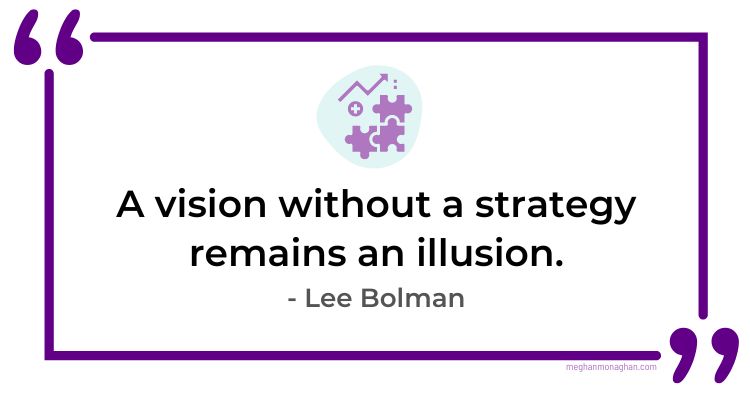
Unfortunately, it can be overwhelming to figure out where to start. Developing a content strategy isn’t intuitive or easy, especially when you’re not a marketing expert.
No worries, my friend! Below, I break down the essential elements of a simple content strategy and provide you with a basic framework to follow for your business blog. And, you can apply this information to your podcast or video channel too.
Successful, profitable content marketing for small businesses always starts with strategy first. After 27 years in marketing, I’ve learned that research and planning reap better results than diving into action without intention and insight.
Note: I’ve splintered off a portion of my Content Profit Plan service to create a straightforward process that everyone can use to create their own content strategy. However, if you want a more robust strategy or need some content marketing help, I’m here for a strategy session!
But first, let’s discuss content strategy a bit more so that we’re on the same page.
What is Content Strategy?
A content strategy is a high-level, documented plan that aligns your blog, video, or podcasting/audio content with your business goals, target market, and your products or services. It identifies content topics that attract qualified leads and makes your marketing more profitable for your business.
You most certainly can—and should—have a content strategy for your email marketing and social media marketing. But those are separate topics not covered in this article.
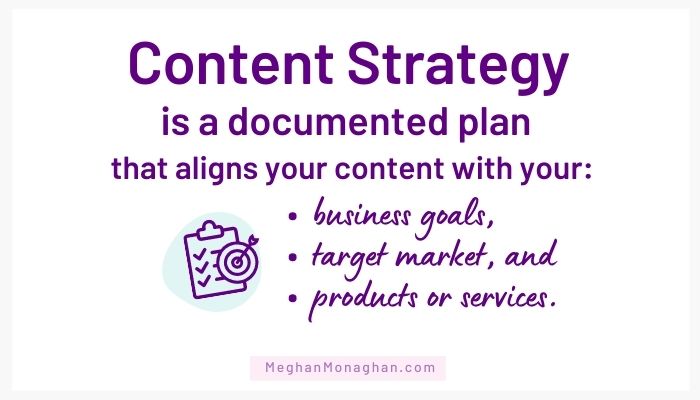
Benefits of Content Strategy: What Does Content Strategy Do and Why Is It Important?
Strategy guides your content creation so that you focus on which topics and themes appeal to and attract your ideal target audience while also supporting your business goals.
If your content attracts the wrong people, then it won’t improve conversion rates. People who aren’t interested in your area of expertise won’t turn into leads or buyers.
Similarly, if your content attracts the right people but doesn’t align with your offers or your business goals, then you’ll hurt your chances of converting website visitors into leads and buyers.
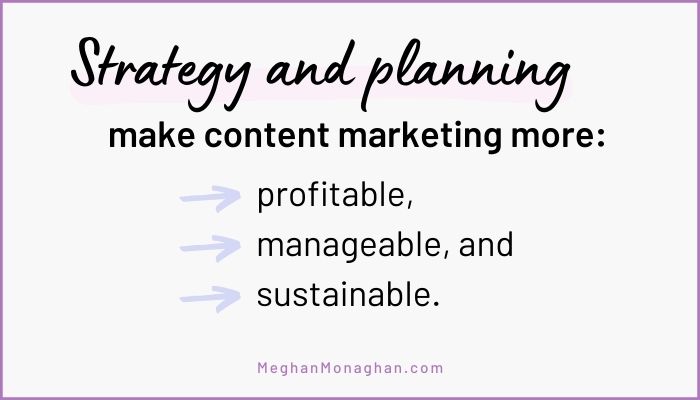
Therefore, content strategy is important because it makes your content marketing efforts profitable and worthwhile.
Plus, I find that strategy makes content marketing easier to manage and sustain on a consistent basis, which is required if you expect it to work.
So, here are a few reasons why content strategy is important:
Better Engagement
Create high-quality material tailored specifically for your target audience’s needs and preferences resulting in increased user engagement and user experience.
Informed Decision-Making
With a solid understanding of what works best for your brand through data-driven insights from analytics tools like Google Analytics or Ubersuggest, you can make informed decisions about which topics resonate most with readers leading to higher conversion rates over time.
Easier Collaboration
Having clear guidelines on how each piece should be written, designed, and promoted streamlines the process for everyone involved in content creation.
Improved SEO
Content is one of the biggest factors in attracting organic traffic and SEO. So, a well-executed content strategy ensures that your website’s pages are optimized for search engines. This makes it easier for potential customers to find you online.
Higher Conversion
Strategy directs your efforts so that you produce relevant content that aligns with your offers and gets more targeted leads into your sales funnel.

One Risk of Not Having a Content Strategy
Although coming up with a content strategy takes time, effort, and expertise, you will not be sorry. In fact, if you skip strategizing and planning first, you’ll run the risk of publishing content that harms your site’s SEO and fails to engage the right audience.
My website is a perfect example of what happens when you don’t have a strategy.
When I started this site as Smart Bird Social, I randomly chose blog post topics that I thought would attract people. And, I listened to bad advice from people who didn’t understand how content and SEO worked.
So, some of my content didn’t align with my services. It failed to target people who would be qualified leads.
My site ranked for search terms like “ebook cover” or “how to drop the background from a photo.” These keywords didn’t align with my services and attracted the wrong people who then quickly left my site…not helpful!
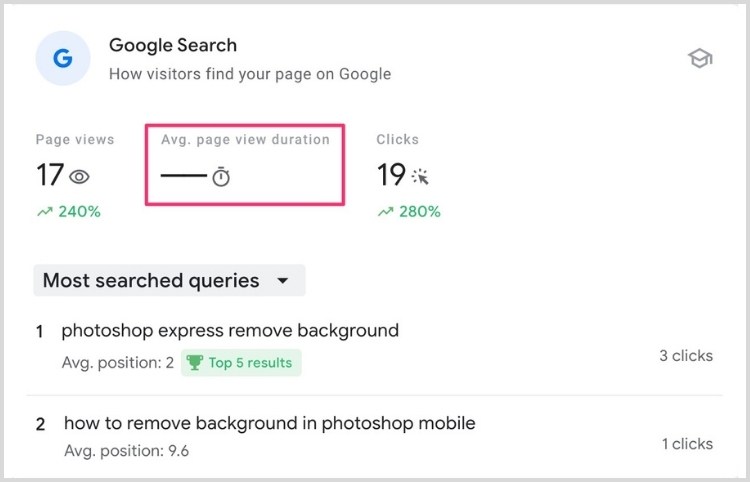
Content Strategy vs Content Marketing Strategy
What’s the difference between a content strategy and a content marketing strategy?
A content strategy identifies your content topics and themes in a blog, vlog, or podcast. That’s not the same as a content marketing strategy, which addresses the plan for marketing/promoting/amplifying your content, often including even the broader content marketing efforts across the board (beyond just one platform).

Social media posts, social media platforms, email marketing, etc. fall under content marketing strategy since they are part of content amplification and distribution.
Many marketing professionals view all of these things as one in the same. That viewpoint isn’t necessarily wrong, it’s simply different from my approach. I differentiate between the two to make them easier to understand and manage.
By the way, “content marketing” itself refers to the approach whereby a business creates and shares non-promotional, helpful content to increase visibility and ultimately attract leads that result in sales over the long run.
Check out Episode 30 of The Messy Desk Podcast to hear more about content strategy!
Why is Content Strategy Essential for Content Marketing?
Haphazard content marketing wastes time and money because it usually performs poorly when it comes to generating leads and sales. That’s why content strategy is important for effective and profitable content marketing. It provides a clear direction and purpose to your content.
A well-defined, successful content strategy identifies a target audience, establishes goals or objectives, and formulates a plan of action, which are required for effective content marketing.
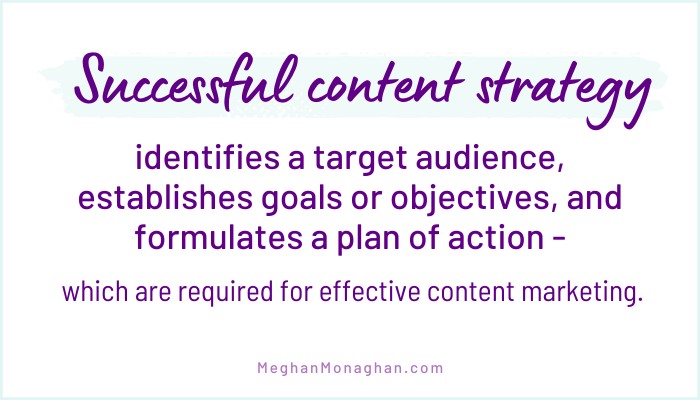
Let’s discuss these three benefits of content strategy in more detail.
1) Helps You Understand Your Desired Target Market – The Who
Successful content marketing depends on identifying your intended audience. By conducting thorough research on your target market, you can create tailor-made content that resonates with them on a deeper level. This step is performed as part of a content strategy. Here are some examples of what to research:
Demographics
Gather information about age groups, gender distribution, geographic location etc., to better understand who you are trying to reach.
Preferences
Identify what types of content they prefer (e.g., blog posts vs videos), which topics interest them most, or how they like consuming content (mobile devices vs desktop).
Pain Points
Determine the problems or challenges that your product/service can help solve; address these issues through informative and helpful articles.
Online Behavior Patterns
Analyze how they engage with similar businesses online to guide your decisions and tactics.

2) Establishes Goals and Objectives – The Why
Why are you using content marketing to generate leads and sales? Your content strategy will answer that by identifying clear goals that align with your overall business objectives.
Thorough understanding of why you’re creating content on certain topics guides you to content marketing that is profitable.
Some common content marketing goals include:
- Increase brand awareness
- Generate leads and sales
- Build an email list
- Improve organic search engine rankings (SEO)
- Educate customers about topics related to products/services
- Nurture relationships with existing clients/customers
3) Guides Your Plan of Action – The What
Once a strategy is done, it’s time to put it into action! A content strategy guides your creation of a plan to carry out your content marketing, namely a content or editorial calendar.
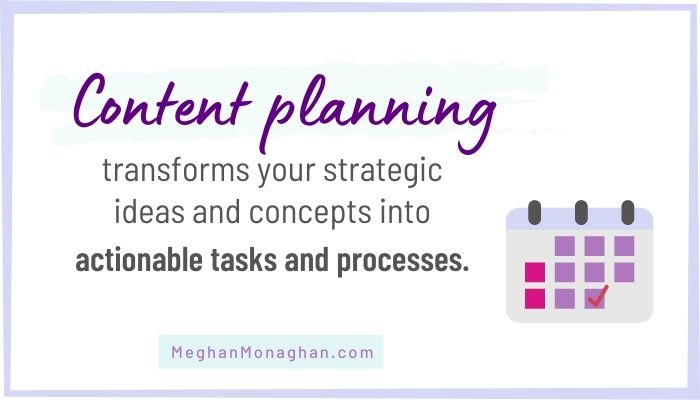
At the least, a content calendar outlines topics, titles, and publishing dates for blog posts, videos, or podcast episodes. However, a calendar can also include other pertinent information, such as author, desired word count, content goals, competition, and whatever else is necessary to capture for content creation and management.
With this in mind, let’s look at how to develop an effective blog content strategy step by step.
Create your own simple content strategy for a business blog with this 3-step framework for beginners.Click To TweetHow to Create a Content Strategy in 3 Steps
Hopefully, you’re convinced that strategy is essential to your content marketing! Because now I’m sharing how you can create a successful content strategy of your own.
This method is a simplified, less in-depth version of my Content Profit Plan, which is my framework for effective content strategy.
NOTE: The goal here is to help you write a high-level strategy for your blog, podcast, or videos that you can use to start thinking about your content in a more strategic, purposeful way. This process is a high level analysis of your content in relation to your target market and business goals, not a deep dive into SEO, competitors, or specific topics.
Step 1: Define Your Target Market (The “Who”)
The first step is to get to know your ideal customer better. Who are the people that you’re creating content for? This is your target market.
Defining who benefits from your products and services helps you to design your content for a specific person, aka your ideal customer avatar, or “avatar” for short.
![]()
To attract your avatar, you must appeal to who they are, what they care about, and what they desire. Although your content represents you and your knowledge, its success relies on grasping what topics your avatar won’t be able to resist. So, you need to know your avatar.
Your objective is to meet them at their struggles and interests using their terminology, not industry jargon.
Sometimes it helps to look at past customers/buyers and see if they have anything common, such as:
- Demographics
- Characteristics
- Preferences
To understand your target market, it may be useful to pinpoint things like:
- age
- gender
- location
- religion
- profession
- identity groups
- hangout places
- preferred books/publications/websites
These things are certainly helpful for advertising, competitive analysis, and copywriting. They can sometimes guide your blog, podcast, or video content too, depending on your industry.
However, when it comes to strategy, I don’t find those things as helpful as a few basic facts.
I recommend that you identify:
- Your avatar’s main struggle that you solve
- How you solve this struggle with your products/services
- The problem your content addresses or solves
- How your avatar benefits from your content
Example:
| Avatar’s struggle | How you solve this struggle | Related content theme or overarching topic | What benefit the avatar gets from the content |
| Need more leads, booked calls, and more clients | Identify ways to use digital and content marketing to attract more leads through content and SEO | How to get more leads and sales through content marketing; how to make content marketing profitable, manageable, and sustainable | Discover how to successfully generate more leads online to get more clients through a manageable content marketing process |
| Keeping up with content creation | Create content or help clients to set up their content marketing lead generation system | Content planning, creation, and management | Understand how to manage content creation without sacrificing time |
This information helps you to craft a Content Mission Statement, which outlines the intentions of your content.
➡️ ACTION ITEM: CREATE A CONTENT MISSION STATEMENT
Use the information from Step 1 above and choose one of the formulas below to craft your content’s mission statement.
FORMULA #1
The [name of your business] [content format – blog, vlog, podcast] helps [short description of avatar] to [problem your content helps to solve] so that they can [insert the big benefit of consuming your content].
EXAMPLE:
The Minimal Marketer blog teaches coaches, consultants, and service providers how to attract more leads and boost their influence with profitable, manageable, search-optimized content marketing so that they generate more leads online and get more clients.
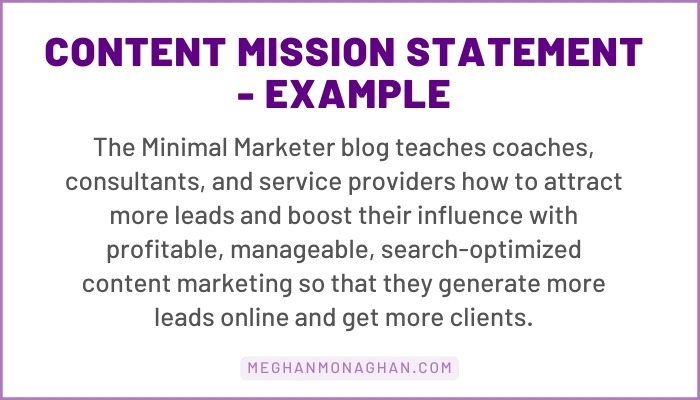
FORMULA #2
The [name of business] [content format – blog, vlog, podcast] [goal of your content] so that [short description of avatar] can [problem your content solves] to [benefit your avatar gets from consuming your content].
EXAMPLE:
The Minimal Marketer blog simplifies content marketing concepts and tactics
so that coaches, consultants, and small service providers can generate leads online to grow their business.
2. Identify Your Business Goals (The “Why”)
Knowing who your content is trying to attract is important. However, you also need to identify what your content accomplishes FOR YOUR BUSINESS.
Why are you publishing content? It’s time to associate your content with business goals.
Goals guide your content marketing decisions and help you analyze your content’s performance. Goals also keep you focused on your “why” so that you create content that grows your business.
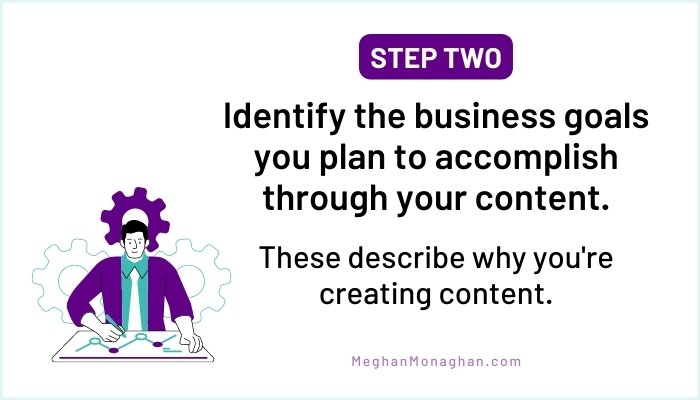
At this point, focus on goals that are actionable and measurable. I recommend that you avoid vague goals, such as to increase brand awareness. It’s tough to measure brand awareness or how it impacts your bottom line.
Set goals that relate to the things in your business that eventually lead to revenue!
> What do you need to happen before people buy from you? or
> What steps lead to more people buying from you?
Here are a few examples of what actions may come as a result of your content marketing:
- Download a free PDF
- Watch a webinar
- Get more consultation calls
- Build an email list
- Acquire more speaking opportunities
Next, make those goals “SMART” and determine Key Performance Indicators (KPIs).
That sounds like a lot of corporate gobbledygook! But, these two things just mean to set important parameters around your goals to make it possible to assess your content’s performance. And, it will also motivate you to make your content more profitable!
SMART goals have specific, measurable metrics and deadlines to each one. KPIs are a measurable value that demonstrates whether or not you’re reaching your objectives or goals. KPIs will show how well your content is supporting your business goals.

➡️ ACTION ITEM: SET A GOALS STATEMENT WITH KEY PERFORMANCE INDICATORS
To assess how well your content is supporting your business goals, set SMART (specific, measurable, attainable, relevant, time-bound) goals and assign metrics to each one.
Here’s a formula to use:
To reach [Desired Goal] by [Number or Percentage] by [Date or Time Frame]
Examples of content goals:
- Get 500 PDF downloads by December 2023
- Increase webinar viewings by 150% by third quarter
- Build an email list to 1500 subscribers in the next six months
With goals set, you have a way to gauge whether your content is supporting your business. And, you’ll understand what you need your content to do, which helps guide what content to create.
3. Determine Your Content (The “What”)
Your “who” and “why” are now clear to you. The last step is to figure out “what” content attracts your avatar and supports reaching your business goals.
What content will you create for your blog, podcast, or video channel?
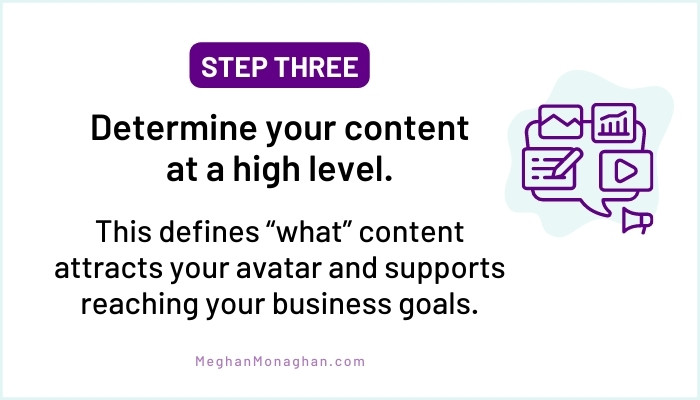
The previous two steps should help guide your content choices. Consider what you know about your avatar and their preferences. Factor in the goals you’ve identified because your content must also support those goals.
Then use that information to guide your content format (written, audio, video / blog, podcast, video).
To define your content, determine the following:
- Publishing frequency (ex. 1x/week)
- Content type (ex. Educational, inspirational, interviews, etc.)
- What you’ll be known as the “go to” person for (ex. topic, subject – I want to be known for “yoga for pregnant women”)
- The primary struggle or problem your content helps to solve for your avatar (ex. How to decrease back pain)
- Who the competition is and what content they’re publishing to establish what’s working and what’s not working and what you’re up against
If you already have content that you’ve published, then consider performing a content audit. A content audit analyzes what topics you’ve covered and the performance of those topics.
➡️ ACTION ITEM: CREATE A CONTENT SUMMARY STATEMENT
It’s time to reflect on the answers and research you’ve collected about your content.
Once you’ve determined the general direction of your content, highlight it into 1-2 sentences.
Summarize what you plan to publish on your blog, vlog, or podcast from a high-level, macro view. The statement consolidates your strategic content planning into a few concise sentences.
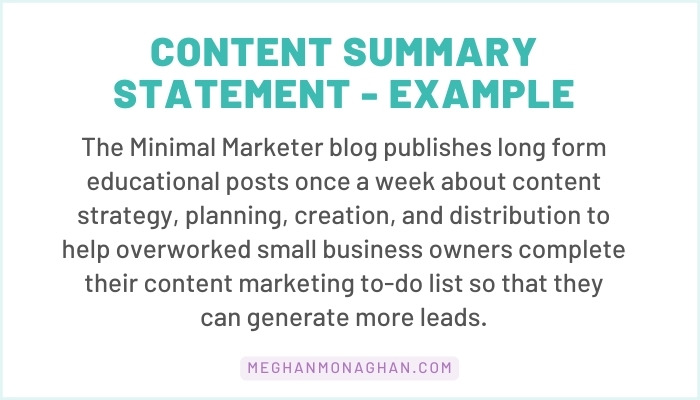
Here’s a formula to use:
[Your business/brand name] publishes [content format – blog, vlog, podcast] [frequency of publishing] about [topic/theme] to help [avatar] to [problem your content solves/transformation your content provides].
EXAMPLE:
The Minimal Marketer blog publishes long form educational posts once a week about content strategy, planning, creation, and distribution to help overworked small business owners complete their content marketing to-do list so that they can generate more leads.
Putting It All Together to Create a One-Page Content Strategy
If you’ve followed along and completed the three Action Items above, then you’re ready to combine them for a simple content strategy. Simply put all three of your statements together on one page, and you’ve got a basic content strategy!
YOUR CONTENT STRATEGY
- [INSERT CONTENT MISSION STATEMENT]
- [INSERT GOALS STATEMENT]
- [INSERT CONTENT SUMMARY STATEMENT]

Print your one-page strategy out and have it handy so that it’s a constant reminder of:
- Who you help with your content
- Why you’re publishing content and your business goals
- What content to publish
You’d be surprised how effective this brief exercise is when it comes to guiding your content efforts! I keep my content strategy one-pager on my desk in a plastic document cover.
Inevitably, I’m always tweaking it, writing on it, then editing and printing it out again. Any, you may do the same as you come to understand your target market better, modify your services, or pivot your content topics.
What’s the Next Step After the Simple Content Strategy Framework?
While a content strategy is awesome, you must transform it into a plan of action. And that plan of action is to create a content calendar!
A content calendar – or editorial calendar – is an organized plan of the content topics that you’re publishing on your blog, vlog, or podcast. The calendar helps you implement your content strategy and improve your content management. You’ll know what content to create, why you’re creating it, and when to publish it.
With the content or editorial calendar, you research content topics and subjects and perform more in-depth analysis of SEO and competitors. But that’s a topic for a different article!
Do You Need Help from a Content Strategy Consultant or Coach?
This post covered a basic, very high-level version of a content strategy. Please understand that I’ve simplified the strategic process to make it easier for those starting out with content marketing. This framework is also good for businesses without a content team.
Going through this exercise may be good enough for your needs. However, if you feel as if you’re out of your element or need a more in-depth strategy, that’s understandable. There are plenty of benefits to hiring a content marketing consultant or coach to help you.
Don’t underestimate the value and expertise an experienced professional offers. I’m here to help!
